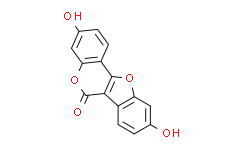| Cas No.: | 479-13-0 |
| Chemical Name: | 6H-Benzofuro[3,2-c][1]benzopyran-6-one,3,9-dihydroxy- |
| Synonyms: | 6H-Benzofuro[3,2-c][1]benzopyran-6-one,3,9-dihydroxy-;Coumestrol;3,9-dihydroxy-[1]benzofuro[3,2-c]chromen-6-one;3,9-Dihydroxy-6H-[1]benzofuro[3,2-c]chromen-6-one;COUMESTROL(RG) PrintBack;3,9-Dihydroxycoumestan;7,12-Dihydroxycoumestan;coumesterol;Cumoesterol;Cumoestrol;Cumostrol;[ "" ] |
| SMILES: | OC1=CC2=C(C=C1)C3=C(O2)C4C(=CC(O)=CC=4)OC3=O |
| Formula: | C15H8O5 |
| M.Wt: | 268.22102 |
| Purity: | >98% |
| Sotrage: | 2 years -20°C Powder, 2 weeks 4°C in DMSO, 6 months -80°C in DMSO |
| Description: | Coumestrol, a phytoestrogen present in soybean products, exhibits activities against cancers, neurological disorders, and autoimmune diseases. It suppresses proliferation of ES2 cells with an IC50 of 50 μM. |
| Target: | IC50: 50 μM[1] |
| In Vitro: | Coumestrol exerts chemotherapeutic effects via PI3K and ERK1/2 MAPK pathways. Coumestrol inhibits viability and invasion, and induces apoptosis of ES2 (clear cell-/serous carcinoma origin) cells. In addition, immunoreactive PCNA and ERBB2, markers of proliferation of ovarian carcinoma, are attenuated in their expression in coumestrol-induced death of ES2 cells. Phosphorylation of AKT, p70S6K, ERK1/2, JNK1/2 and p90RSK is inactivated by coumestrol treatment in a dose- and time-dependent manner[1]. Coumestrol inhibits proliferation and induces apoptosis in MCF-7 cells, which is prevented by copper chelator neocuproine and ROS scavengers. Coumestrol treatment induces ROS generation coupled to DNA fragmentation, up-regulation of p53/p21, cell cycle arrest at G1/S phase, mitochondrial membrane depolarization and caspases 9/3 activation[2]. |
| Cell Assay: | To determine dose-dependent effects of coumestrol, ES2 cells are treated with different concentrations (0, 1, 10, 20, 50 or 100 μM) of coumestrol[1]. Coumestrol is dissolved in DMSO to prepare a 3 mM stock. Breast cancer MCF-7 cells are treated with increasing concentrations of coumestrol for 24, 48 and 72 h. Then, 20 μL of MTT (5 mg/mL) is added each well and re-incubated for additional 3 h. Formazan blue crystals formed are dissolved in 100 μL of DMSO. Absorbance is read at 570 nm using ELISA plate reader[2]. |
| References: | [1]. Lim W, et al. Coumestrol suppresses proliferation of ES2 human epithelial ovarian cancer cells. J Endocrinol. 2016 Mar;228(3):149-60. [2]. Zafar A, et al. Cytotoxic activity of soy phytoestrogen coumestrol against human breast cancer MCF-7 cells: Insights into the molecular mechanism. Food Chem Toxicol. 2017 Jan;99:149-161. |

 DC Chemicals' products qualify for U.S. tariff exemptions. We guarantee no price increases due to customs duties and maintain stable supply, continuing to deliver reliable research solutions to our American clients.
DC Chemicals' products qualify for U.S. tariff exemptions. We guarantee no price increases due to customs duties and maintain stable supply, continuing to deliver reliable research solutions to our American clients.





















